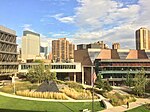Basilica of Saint Mary (Minneapolis)
1871 establishments in Minnesota20th-century Roman Catholic church buildings in the United StatesBasilica churches in MinnesotaBeaux-Arts architecture in MinnesotaChurch buildings with domes ... and 7 more
Churches in the Roman Catholic Archdiocese of Saint Paul and MinneapolisChurches on the National Register of Historic Places in MinnesotaNational Register of Historic Places in MinneapolisNeoclassical architecture in MinnesotaRoman Catholic cathedrals in MinnesotaRoman Catholic churches completed in 1907Roman Catholic churches in Minneapolis

The Basilica of Saint Mary is a Roman Catholic minor basilica located on its own city block along Hennepin Avenue between 16th & 17th Streets in downtown Minneapolis, Minnesota. It was the first basilica established in the United States. The Basilica of Saint Mary is the co-cathedral of the Roman Catholic Archdiocese of Saint Paul and Minneapolis.
Excerpt from the Wikipedia article Basilica of Saint Mary (Minneapolis) (License: CC BY-SA 3.0, Authors, Images).Basilica of Saint Mary (Minneapolis)
Hennepin Avenue, Minneapolis
Geographical coordinates (GPS) Address External links Nearby Places Show on map
Geographical coordinates (GPS)
| Latitude | Longitude |
|---|---|
| N 44.973055555556 ° | E -93.286388888889 ° |
Address
Basilica of Saint Mary
Hennepin Avenue
55403 Minneapolis
Minnesota, United States
Open on Google Maps









